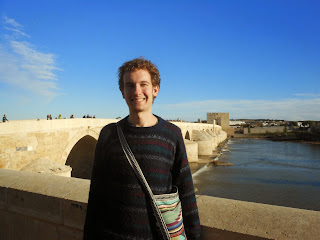The other weekend, Natalie and I planned our first overnight trip to the city of Córdoba in the south of Spain. It is fairly close to Madrid, and only took us about five hours by bus to get there. Córdoba is a city with a very rich historical and cultural heritage. It was the capital of the Islamic empire that ruled in Spain during much of the Middle Ages, and still contains much Arabic and Arabic-influenced art and architecture. Its most famous landmark is an enormous mosque in the center of town. There are also many remains from Roman times to be found throughout the city, including the Roman bridge that spans the Guadalquivir River and ruins of other structures such as amphitheaters and aqueducts.
 |
| Me in front of the Roman Bridge |
 |
| A Roman mosaic from the third century! |
The Alcázar
Another one of Córdoba's sights is the Alcázar, or royal castle, which is where Isabel and Ferdinand famously received Christopher Columbus before he set off on his first journey to the Americas! Alongside the castle were some lovely, expansive gardens with lots of ponds and orange trees.
Madinat al-Zahra
A short bus ride outside Córdoba are the ruins of the 8th century royal city of Madinat al-Zahra. It was built by Abd-al-Rahman III, who was then the ruler of the Islamic empire in the Iberian Peninsula, as a symbol of and testament to his power as the Grand Caliph, or Islamic ruler. The city was built onto the side of a hill, which makes for spectacular views of the surrounding planes and the far-off mountains. The palace which the Caliph built for himself here is considered one of the most important archaeological sites for studies of early Islamic art and architecture. Legend has it that, in this palace, he threw extravagant and elaborate dinner parties which involved pyrotechnics, tables and chairs set on rotating platforms, mirrors and special lighting effects, as well as a bed which floated on a pool of liquified lead! Sadly, this part of the ruins was closed for restoration.
Streets & Patios
Wandering down the tiny, alley-sized, cobblestone streets of Córdoba, Natalie commented to me that this was what she had always thought of when she thought about a typical city in Spain. Aside from its many historical attractions, simply walking around Córdoba is a pleasure in and of itself (except when cars come whizzing down the tiny streets and you have to run and squeeze yourself into a doorway to make room!). Even the street signs have a charm of their own!
What's more, Córdoba is well-known for its patios. And yes, this is basically just referring to the patios and courtyards of regular apartment buildings. They are usually decorated with beautiful tiles called azulejos which are typical to the southern regions of Spain. In May, there is a famous Festival of the Patios in which many apartment buildings and private homeowners decorate their patios to the max with blooming flowers and blossoming orange trees, and then open them up for the public to enjoy! Considering how beautiful everything was even now at the start of winter, I can't imagine how nice it would be in spring!
The Great Mosque
The most famous attraction in Córdoba is its Great Mosque. This religious building was constructed over the course of many centuries, successive caliphs adding on to the original structure. It was begun in 784 and the last phase was completed in 987. Then, when the Christians "reconquered" these lands in 1236, a cathedral was built in the middle of the mosque, and it has since been used as a Christian place of worship.
Nevertheless, in historical and art-historical terms, it is one of the most important early Islamic monuments in the world today. Many of the techniques and styles it employed were influential in the design of later mosques and other Islamic buildings.
 |
| The courtyard, full of orange trees |
 |
| One of the side entrances, now closed |
 |
| The ceiling of the mihrab room. Sadly you can't see, but the colors of the tiles in the ceiling were one of the most beautiful things I've ever seen! |
 |
| The most iconic part of the mosque are these repeating columns with horseshoe arches |
It's impossible to capture the impression that all of this made when combined together. These columns and arches, repeated over and over again across a space almost a block long; the incredibly ornate and resplendent nature of the glass mosaics; the dark, rich texture of the walnut pews in the choir loft. We spent an entire hour just walking around and soaking up everything that this building has to offer. It was clear why it is one of the most famous monuments in all of Spain!
















































